A Week After Easter
| A week after Easter, rosebuds crown every bush And pigeons grow plump in the yard. Dogs spy a squirrel high in the live oak And spring’s chatter begins Even the jay’s shriek is vital After a winter deader than most When we journeyed down a stymied road With little horrors at every turn, And big horrors too. It seemed that the very earth Let out a long sigh, Dust blew into every eye, And tears turned to mud. No one could discern a direction, So we stumbled on, Welcoming at least The quail deep in shadows And the throaty call of the dove Unseen amid at least warm leaves. |
Newly blooming flowers and nesting birds lift our hearts when April arrives and appear in every form of spring-inspired art throughout the world, as birds and flowers are eternal symbols of spring. The egg, long associated with Easter, is also an archetype for new birth. In the Middle Ages, when serious fasting and abstinence took place during the season of Lent when the faithful embraced acts of penance, even eggs were prohibited from the Lenten diet. When Easter arrived at last, not only did Christians celebrate resurrection and renewal, but they were overjoyed to be able to eat eggs again!
Our website and blogs are filled with all sorts of delicious egg dishes. One of my favorites is the Artichoke Cheese Frittata, loaded with eggs and cheese and featured in my January 2020 blog. I have been making this easy to prepare classic for years, as it is my guests’ favorite savory at Afternoon Tea and is also a perfect appetizer in any season. For an elegant and special occasion, you might want to make Arpege Farm Eggs, inspired by Alain Passard, chef of the three Michelin-starred restaurant in Paris, L’Arpege. We enjoyed this astounding sweet and savory poached egg at Manresa in Los Gatos, California, founded by David Kinch, who was mentored by Passard and has now earned a Michelin star of his own. You can find the recipe, which combines, sea salt, chives, spices, cream and maple syrup with a subtlety that will take your breath away, in my October 2017 blog. Another timeless egg preparation is Tea Smoked Eggs, a Chinese classic, in which boiled eggs are gently cracked and simmered, still in their shells, in a lightly sweetened broth of Lapsang Souchong Tea and soy sauce. When the eggs are peeled, the dark broth which seeped into the cracks, leaves a unique, wispy brown pattern on each egg along with an enchanting smoky tea flavor. My February 2020 blog shows you the easy steps for making Tea Smoked eggs at home. My family loves them!
Easter also brings the delightful challenge of figuring out what to do with all those beautifully decorated boiled eggs after the morning hunt is over. The answer is Deviled Eggs! Anyone who has looked at our website carefully has noticed that this treat, loved by young and old, appears on many of our Afternoon Tea menus. Who doesn’t love this pretty finger food, sprinkled with festive paprika, or even curry powder? And even a person who has no idea how to cook can peel some boiled eggs, cut them in two and mash up the yolks with salt and pepper, mayonnaise, a little mustard and perhaps a dollop of sweet pickle relish to taste. Some lovely fresh spring herbs, finely chopped and sprinkled on top, can turn this American icon into a work of art.
In our family, it isn’t a party if there are no Deviled Eggs. My niece and co-author Kathleen carries this philosophy forward by offering some easy adaptations to add extra spring charm to Deviled Eggs in two of her April blogs. Her beautifully photographed April 2021 blog highlights Deviled Eggs garnished with bright green asparagus tips. And her April 2018 blog includes the recipe for Lightened Up Deviled Eggs, a lower-fat version with clever ideas for springtime garnishes such as dill or pickled okra. My mother, Dr. Betty Murdock, also had some quirky and quite delicious ways of introducing boiled eggs into both our everyday and holiday meals. When she made meatloaf, she would put half of the ground beef mixture into the baking dish and place a row of three or four boiled eggs, end to end, down the center, and then cover them with the remaining meat mixture, patting it carefully into place to hide the eggs. The result was a delightful surprise of meatloaf with well-seasoned slices of boiled egg in each serving. Dear Betty was also famous for adding boiled eggs to the gravy on every Thanksgiving, Christmas and Easter family dinner. I loved to make a little dent in my serving of mashed potatoes, plop a boiled egg in the center, and pour my mother’s home-made gravy over this pretty little edible volcano.
As you may have guessed, eggs are one of my favorite foods, and although they should be eaten in moderation, they are an excellent source of protein. And like so many of our other favorites, they can be enjoyed in either savory or sweet preparations. Also, like fish, nuts and cheese, eggs harmonize beautifully with one of April’s other precious gifts—spring herbs. When I was a child, eating my grandmother’s excellent Ozark cooking, herbs were never included in daily meals; in fact, salt, butter and pepper, and perhaps a bottle of Worcestershire sauce in the cupboard, were the only flavorings used to enhance the natural tastes of our daily diet, which consisted primarily of potatoes, corn, beans, chicken and eggs. An occasional green onion or tomato pulled out of the back yard garden was about all we ever did to perk up the subtle flavors of these food staples.
When my family moved to California, a whole new world of flavors entered our lives. California is indeed a paradise of multi-cultural cooking, influenced by the cuisines of Mexico, Italy, Japan, South-East Asia and all the Mediterranean areas, each of which is loaded with fresh herbs. And California cuisine, inspired by these and other cultures, is itself characterized by the inclusion of fresh, local and natural herbs. In fact, many restaurants in California today, have their own herb gardens. The first fresh herbs I remember eating were bright green chopped chives sprinkled over baked potatoes with sour cream. So simple, but so delicious and still popular today.
Fresh herbs, which pop up in grocery stores and home gardens every April, include not just the four favorites from the song “Scarborough Fair,” parsley, sage, rosemary and thyme, but also mint, cilantro, basil, dill, bay leaf, chervil, coriander, marjoram, oregano, savory and tarragon. As the ever-reliable Fanny Farmer Cookbook points out, “Herbs should never overwhelm a dish. The purpose of any seasoning is to provide an accent that enhances natural flavors.” I have found that cooking with these lovely little edible green plants can add a special note of fresh and cheery zest and indeed enhance the flavor of even to the most ordinary dish. Try stirring a little chopped fresh flat-leaf parsley or basil into the scrambled eggs for breakfast, and voila! Gourmet eggs! Parsley can also be added to melted butter to pour over lightly boiled tiny red potatoes and fresh spring peas or as a bright, edible garnish to soups, stews, any roasted vegetables or spring salads.
Fresh herbs are not very fussy about whether you add a lot or a little, and many herbs bring delightful color as well as subtle flavor enhancement. Rosemary is one of my favorite herbs, as it blooms in the spring with beautiful, fragrant blue flowers and has an enchanting aroma. I like to add a few whole sprigs of rosemary to oven-roasted vegetables, such as carrots, potatoes, onions and whole heads of garlic, lightly sprinkled with sea salt and coarse pepper and drizzled with olive oil. After roasting the vegetables for about an hour at 350 degrees, the rosemary sprigs will have shriveled up, but the fragrance will remain. Before serving, I simply remove the cooked rosemary sprigs from the roasting pan and replace them with fresh, bright green uncooked sprigs for a beautiful and enticing presentation. Indeed, sprigs of rosemary look beautiful as a garnish on any spring vegetable, meat, egg or cheese dish, gently placed on top of a quiche, a pan of macaroni and cheese, beside a plate of warm, buttery mashed potatoes, or on a platter of spring lamb.
You can cook with either dried or fresh herbs, although fresh herbs are preferable. Just remember that dried herbs, which have been dehydrated, provide a more condensed flavor and should be used sparingly. At least double the quantity of fresh herbs can be used to enhance the same dish. A well-known dried herb combination used in French cuisine is Herbes de Provence, a mixture of rosemary, marjoram, thyme, savory and sage. Usually no more than one half teaspoon to one teaspoon of dried Herbes de Provence is needed to flavor a vegetable soup, roasted chicken or fish dish. A few sprigs of the fresh versions of these herbs can be tied together with kitchen twine in a small piece of cheesecloth to form a bouquet garni, a little bundle of herbs which can be tossed into the cooking pot or casserole dish to flavor sauces, soups, stocks and broths.
Bay leaves are also often included in bouquet garni, or simply added to the roasting pan when cooking meat dishes, especially pot roast. Bay leaves impart a fragrant and pungent flavor, but they should be removed before serving the meat to your guests. Basil is another beautiful herb, which is easy to grow in a home garden and is an essential element in Thai and Italian recipes. Basil pairs perfectly with tomatoes and is one of the key ingredients in the world famous Italian Caprese Salad, a simple combination of slices of fresh mozzarella cheese, tomatoes, chopped fresh basil, salt and drizzles of olive oil. And what would lunch at a Vietnamese Pho restaurant be without fresh basil? With every serving of this delicious noodle soup, enhanced with thin slices of beef or other ingredients of the diner’s choice, a plate of fresh basil, still on the stem, beans sprouts, sliced jalapenos and fresh lime wedges is brought to the table so each guest can tear off some basil leaves and add them, along with the other offered fresh ingredients, right into their bowl of Pho. All of us can learn, through experimentation, to make our home cooking even more delicious by adding fresh herbs. Nothing bad will happen if you use too many or not enough, and many herbs are happy to be combined with other herbs that flourish in the spring.
I hope you will enjoy including eggs and herbs in your Passover, Easter and other spring family celebrations. And let’s not forget that most of our favorite cakes, custards and desserts include eggs. This year, for our Easter family meal, I plan to bake Ellen’s Fabulous Coconut Cake, featured on our website in the American Southern Tea menu in the “A World of Tea Parties” section of “The Tea Book.” I have baked this beautiful cake, shared by Kathleen’s dear friend Ellen, (see Kathleen’s March 2017 blog) many times, and it always makes any special occasion even more special.
This beautiful white cake is loaded with coconut, coconut extract and five extra-large eggs. If you have a cake pedestal, use it, and as this regal creation deserves to be elevated and celebrated. It is elegant in every season, including Christmas, but since I will be serving it this year at Easter, I plan to surround it with pretty pastel chocolate covered almonds. Fresh roses or other spring flowers circling or topping the cake would also be nice, perhaps even a few sprigs of rosemary in bloom.
- 2 cups sugar
- 1 cup (2 sticks) unsalted butter, softened
- 5 large or extra-large eggs, at room temperature
- 2 cups flour
- 1 ½ teaspoons baking powder
- 1 teaspoon salt
- 1 cup buttermilk, at room temperature
- 1 cup very lightly toasted sweetened angel-flake coconut
- 1 ½ teaspoons coconut extract
- Cooking spray with flour for the pan
- 1 cup sugar
- ½ cup hot water
- 1 teaspoon coconut extract
- 1 cup very lightly toasted sweetened angel-flake coconut
- Fresh flowers, fresh strawberries or raspberries or small pastel chocolate Easter eggs
Makes: 12-16 generous servings
- Spray the Bundt pan with cooking spray with flour and set aside. Spread 2 cups of coconut evenly on a foil-lined cookie sheet and toast very lightly in the pre-heated oven, stirring every couple of minutes with a heat-proof spatula just until the edges are very lightly browned, about 5 minutes, total. Be careful, as coconut can burn easily and must be stirred to prevent the outer edges from turning too dark. Remove the coconut from the oven and cool on a wire cooling rack. Divide the coconut evenly into two small bowls, one cup each. Set aside.
- Place the softened butter and 2 cups sugar in a large mixing bowl and beat with an electric mixer until light and fluffy, about 4 minutes. Add the eggs, 1 at a time, beating well after each addition. Sift the flour, baking powder and salt into a medium sized mixing bowl. Add the dry mixture to the butter mixture alternately with the buttermilk, mixing just until well combined. Stir in 1 cup of reserved toasted coconut and 1 ½ teaspoon of coconut extract.
- Pour the batter into the prepared Bundt pan and bake for 50-60 minutes or until a wooden skewer inserted in the center comes out clean. As the cake bakes, prepare the coconut syrup. In a large glass measuring cup, combine 1 cup of sugar and ½ cup of hot water, stir briefly and microwave for 2-4 minutes, until the mixture comes to a boil, stirring twice. Stir in 1 teaspoon of coconut extract. Set aside.
- When the cake tests done, place the pan on a wire cooling rack for 15 minutes, then turn the cake out onto the serving platter or cake pedestal. Poke holes in the warm cake with the wooden skewer and slowly pour the coconut syrup over the cake until it is completely absorbed. Sprinkle the remaining cup of toasted coconut over the cake. Don’t worry if some of it falls into the center tube or around the edges of the platter.
- Garnish this glorious cake to your liking with fresh flowers or flowering herbs, fresh berries, small chocolate Easter eggs or pastel chocolate covered almonds. Serve with freshly whipped cream or ice cream if you wish.

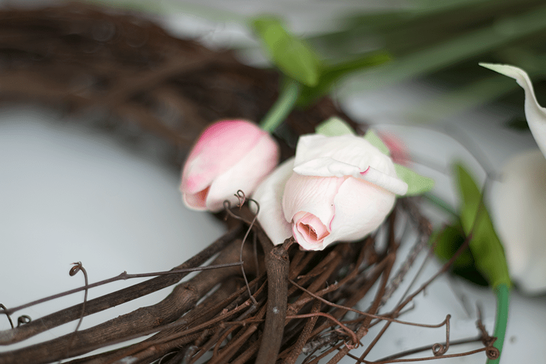
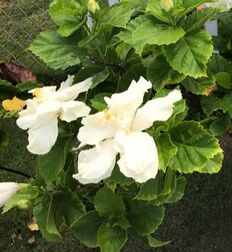
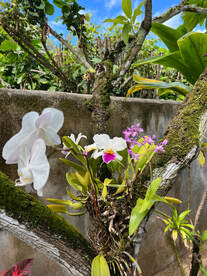
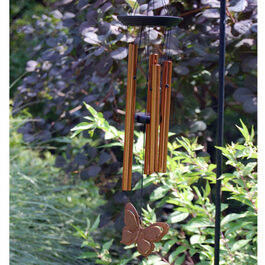

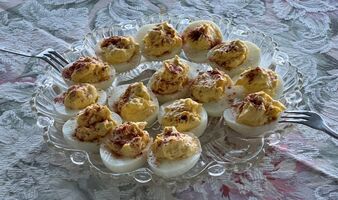
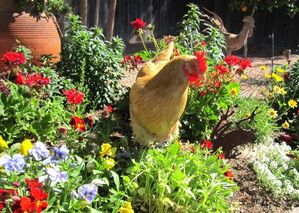




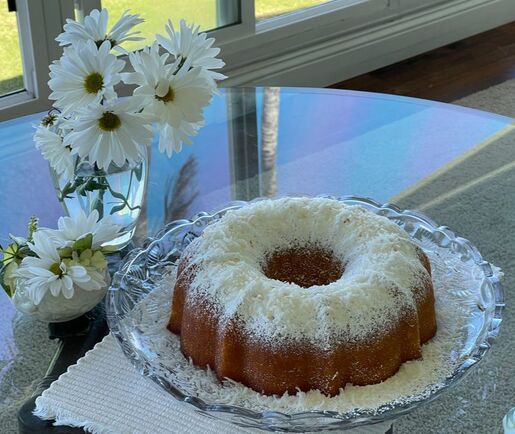
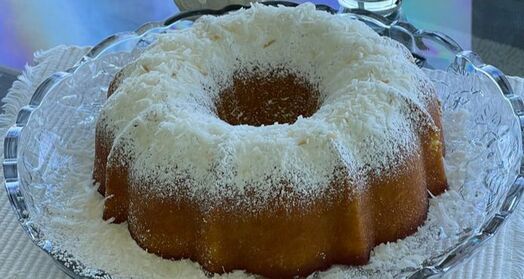
 RSS Feed
RSS Feed